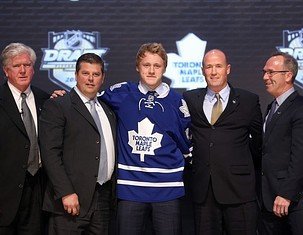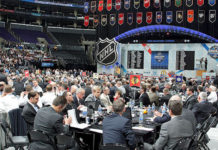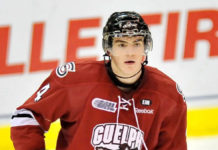
According to Darcy Regier, “The NHL Amateur Draft produces, on average, 54 players [who play at least 80 NHL games in their career] a year — 1.8 per team — I think.”
Think about that. Only 54 players per draft play at least 80 NHL games. That means Mike Zigomanis qualifies as one of those “NHLers.”
The draft is a time for many things: hope, optimism, change, but perhaps most importantly (and foolishly) it is a time for false belief. Fans, especially fans of teams who are struggling, look at the draft and expect so much from it. The truth is though, if you draft one really good NHL player, you’ve done well. If you draft two solid NHLers, you’ve done above average. Three? Well, that’s basically a special draft all things considered.
So if you’re apart of the Leafs organization and waking up this week, you have to feel pretty good about a draft that netted you two players that you (and many others) ranked as first rounders, especially when one is a guy you ranked first overall (more on that below).
Maybe the Leafs have too many defense prospects, maybe they don’t, but if you have the opportunity to draft two guys who you think are going to be NHLers, you have to do it. It’s a lot easier to trade out guys who can play hockey at the pro level and address needs that route, versus reaching in the draft to fill needs by selecting a player you think has less of a chance of making the NHL and/or becoming an impact player at the next level.
Unlike the NBA and NFL, you can’t really draft for need in the same way. When you draft a guy, you usually wait 3-5 years to see some legitimate payoff from these guys. So really, who is to say what the Leafs will need at that time?
That’s why, if you’re the Leafs, you’re loving that you drafted two guys that you rated highly and think will make it at the next level. The best organizations consistently draft NHL players, position be damned. When you have a logjam at one position (as the Leafs just did/still do with Schenn being traded), it allows you to move a position of strength for a position of need. Nikita Filatov, who went to Columbus right after the Leafs selected Schenn in 2008, was a guy who the Leafs arguably “needed” as a high talent forward who had the capability of being an offensive force. Should they have reached for him not only would they not have JVR right now, but they wouldn’t have any NHL player to speak of altogether.
Moving on though, I spoke with Brian Huddle, who is a scout for Future Considerations and prospect writer for HockeyBuzz, about the Leafs draft. I also tacked on some of my own thoughts below his responses to each question. For the record you can follow/interact/thank Huddle on Twitter here: @BrianHuddle.
1) Everyone will talk about Rielly’s speed and talent over the next week, but can you offer us something else about his game that’s under the radar or surprised you?
Brian Huddle: Obviously he—s not a big guy”listed around six feet at the moment, but I was always surprised by how much of a reach he has because of that. Defensively he shows good understanding of lanes and how to use his stick, but the reach he has makes for an extra obstacle for forwards to have to maneuver around.
Anthony Petrielli: I’ll add something that isn’t talked about enough when it comes to this kind of player: Everyone says these smaller, quicker, defencemen are horrible defensively (see Karlsson, Erik) but how much defense do they actually need to play when they are dominating the puck offensively every shift? I don’t believe “the best defense is a good offense” but I do believe prospects are nitpicked a little too much when their deficiency is something that does not regularly come into play.
2) There will be a lot of talk about Burke saying that Rielly was ranked number one on their board. Now you and I have already talked about this and both believe him, but can you shed some light as to why you do?
BH: I—ve seen a lot of mockery on Burke—s head for this, just like I saw a lot of people saying Edmonton would be flat out dumb to take anybody but Yakupov. Strictly speaking, every list by every scout is completely different. One player may be better now, but projecting is part of the scouting business.
As for Rielly being number one, it wouldn—t surprise me at all given that Rielly could very well have been in that conversation had he played the full season. His puck skills and skating are above many of the best forwards in this draft, not just defensemen. He—s got elite skills (passing, skating) to go with his work ethic, character and high end vision.
AP: When scouts build their final draft board, they often start by breaking players off into “tiers.” So, in a regular draft, you have maybe one or two elite players in tier one, maybe perennial all-stars in round two, top six/top four players in tier three and so on. Some scouts, for example Craig Button (and I understand he’s maybe not the best example in some people’s eyes), don’t fret over ranking a player 13th instead of 15th as long as they have them in the proper grouping.
Needless to say, there were many scouts who did not believe there was one elite player in this draft. So that means many teams would group together a bunch of players in the top tier of their draft board and then go from there. For argument’s sake, let’s say the Leafs had Yakupov, Galchenyuk and Rielly in their top tier. If they did, I think most of us know Burke would value a defenceman over two forwards because that’s his hockey philosophy. That’s also why he probably said he was considering drafting for need instead of sticking to his board.
For the record, I’m not saying I agree with Burke ranking Rielly number one (because I don’t, and I wouldn’t have drafted him first overall), but I definitely see how they could have come to that conclusion. On a larger scale, I wish he just wouldn’t have said anything altogether though. Has he not learned anything about this market yet?
3) I’d consider it fair to call Guelph a bit of a surprise team this year in terms of how well they played. So how big apart of that was Matt Finn?
BH: Finn was, for most of the year, Guelph—s best player. I made a remark on Twitter a couple months back while watching them play Sarnia that it felt like he played every other shift. Most believe he probably clocked in around 30-35 minutes a night this past season, so it—s understandable that he was a big part. In saying that, he faced a lot of tough opponents and made the best of the situation, in both ends. He ended his regular season in sixth for OHL defenseman scoring, behind the likes of Ryan Murphy, Dougie Hamilton, and Cody Ceci. He was able to give reliable minutes, produce offensively, and be used in a shutdown role at times.
AP: Scott Walker, the coach of the Guelph Storm, had a much publicized heart-to-heart talk with Finn at the end of last season about his conditioning and overall play. Obviously, Finn took the initiative and came back strong this year. If he didn’t, it’s arguable that Guelph doesn’t even make the playoffs this season. There’s just something to be said about a kid who really works that hard to improve over the summer and then competes the way he did this year. “Compete level” is something that Burke and his scouts value highly. It was the first thing Morgan Rielly said he brings to the table when James Duthie interviewed him right after the Leafs drafted him.
4) Ryan Rupert is a player you have seen a lot of in London. He definitely brings the aggression and hostility that Burke and the Leafs are looking for on the lower lines, but his size (5’9) has to be a concern. What do you make of that and do you think he’ll be able to overcome it at the next level?
BH: Peter Chiarelli had something to say on smaller height players, saying that Boston—s scouts found weight correlated more to NHL success that height. A scout I—ve talked to a lot added to that, mentioning he liked a good height/weight ratio rather than pure height. With regards to Rupert, he—s a meaty guy coming in around 185 lbs currently. Rupert is a guy who not only is pesty, but he—s skilled. London uses him on the PP as a distributor because of his puck skills”playing the half-wall and coming back to the point. Not only that, but he played a top six role on the OHL Championship team, so there—s obviously something there.
In my dealings with both of the Ruperts, I got a real sense that hockey was pretty much everything to them. If you believe in the idea that will and skill will lead to a career, then you have to believe they—ll have a long one.
AP: There’s something to be said of a player who will do anything to win, and Rupert is definitely one of those players. That probably doesn’t mean much when it comes to whether he’ll become an NHLer or not, but just having that kind of player in your organization — even if it is just in the AHL — is nice to have. As Huddle points out above, Rupert has so many different dimensions to his game that I’d like to think he could carve out some sort of niche at the pro level and potentially get to the NHL, height issues be damned.
5) This is the third time Burke has drafted a high school player (Everson and Cameranesi are the others), what do you make of drafting players from that level, and can you tell us anything to look out for when it comes to Dominic Toninato specifically?
BH: I—ll be completely honest in saying I know absolutely nothing about Toninato. I understand he played a couple games with Fargo Force, but never caught any of them, unlike catching a couple of Everson—s games with the NTDP last year.
As for high school hockey, I do wonder how well it translates. Obviously there are those who can and do overcome playing in a lower level to the college ranks and eventually the pro game, but it looks few and far between as they tend to be a bit more of the long term variety and teams tend to let them go fairly early on in their careers.
AP: Drafting high school players is an interesting idea, and this isn’t the first time Burke has done so with the Leafs (Cameranesi and Everson were high school picks last year). Essentially you’re taking a huge shot in the dark. You’re drafting a kid who is so underdeveloped that you really have no idea what kind of player he’ll be, but maybe you see some facet of a players game that you like and you select him hoping that he’ll figure out the rest (for example– take a player that’s really fast and hope the rest of his game rounds out).
I spoke with a scout who watches Minnesota high school hockey and also writes for Future Considerations – who you can follow on Twitter here: @Schraderd – about Toninato specifically and he offered this:
“Has decent size + able to handle more muscle mass. Good instincts, no standout trait though. Skating need works. Split opinions on him; some thought he was the top MNHS (Minnesota high school player), others “no prospect.” I’m in the latter. [Toninato] played with the same line mates on a powerhouse team for years [and] maybe a product of that. Not overwhelming play outside of the HS level and I’ve seen him at Elite League (MNHS selects) and USHL levels, where skill and speed is higher than HS. That said, he’s competitive and feisty. I’m not sold on his hockey sense being high end, but its decent.”
Sobering thoughts to say the least. We wont see Toninato for 3-5 years anyways, if at all.
6) Sometimes when you draft players you look for guys who are in bad situations and thus fall through the cracks and under the radar. Connor Brown qualifies as one of those guys playing for Erie (where he was -72), do you think he has a shot and could possibly be a good player in a bad situation?
BH: Let me preface this by saying Erie was downright awful. The guys who were traded out of there mid-season saw their fortunes completely turn around and the difference of splits in stats is really quite interesting to take a look at (Greg McKegg anyone?). The low down on Brown is that he—s offensively talented with good puck skills from the outside, who can make plays and finish them off. He moved around a lot in Erie, starting with Olden—s line, then McKegg—s line and eventually finishing off the year playing with Dane Fox post-trade. He was able to continue to produce and lead Erie offensively despite the turn table of linemates.
Brown tends to strike me as a guy who can add some offense, but doesn—t really set one skill apart in that regards to find himself a niche. The one thing I—ll look for with him is adding strength, and starting to work on his 200 foot game, if he plans on playing in a top nine role down the road.
AP: In the first few rounds it’s pretty easy to identify the top talents and the best players on the best teams and select them. When you get this late in the draft, you have to start looking at players and taking other factors into account. When the Leafs selected Jerry D’Amigo, he was the leading scorer on a gold medal winning U18 USA team yet he had size issues. Late in the draft that’s the kind of risk you take. This year, the Leafs obviously look at a guy like Brown and think that they see a good player on a bad team who kind of got lost in the overall shuffle of the draft. I can’t tell you whether Brown will become an NHLer or not, but I like this line of thinking late in the draft.
7) Upon the completion of this draft, what do you make of the Leafs system on the whole? There seems to be an abundance of NHL caliber prospects, but a lack of high-upside players. Do you agree? And how do you break them down by position?
BH: As far as system we—ll have to remove Gardiner from the talks, obviously. What I see is two players who could really be something in Nazem Kadri and Morgan Rielly, and then a plethora of players who can find complementary roles on the 2nd/3rd line or 2nd/3rd pairing. What does this mean to me? Well, it means Burke has the ability to add to deals because of the depth, but also that we may find the Leafs in a place where once they find their elite talent for the first line/pairing, that they—ll have cheap reliable options to fill out the roster over the next couple of years.
Obviously, the bulk of the high end talent for me is on the back end with Rielly, Finn, Percy and Blacker, (without mentioning one Jake Gardiner). But they also have a good deal of top nine winger prospects — Biggs, Ross, D—Amigo, Ashton, Deschamps, to name a few, are the names we could see flanking the imaginary centers one day. My concern is the lack of true centers in the organization past the NHL level. Kadri has been moved around from the middle to the wing and back, and we—re not sure where he—ll ultimately end up. Colborne at this juncture is the only real center with that upside for a top six role down the middle, with Greg McKegg looking more like a winger in recent days.
AP: I don’t think there’s a ton for me to add to what Huddle just said, but it is worth noting the Leafs only have one goalie prospect who isn’t with the Marlies/Reading Royals and that’s Garret Sparks. Eventually they’re going to need to replenish their system there because that is just not enough. For that reason, I thought it was pretty curious for the Leafs not to draft a goalie.
The hole at center is also somewhat alarming throughout basically the entire organization at this point. Good teams have two, sometimes three, really good centers down the middle and right now the Leafs have one (Grabovski) with only maybe Colborne on the way from the prospect cupboard.
—
To end this off, I wanted to point out something that I thought was just so awesome this weekend. Scroll to around 7:15 of this video and watch Morgan Rielly’s dad’s reaction to his son being drafted by the Toronto Maple Leafs. What a moment. Sometimes we all take hockey just a little too seriously and forget what this game is all about: Fun. I think my favourite part was Morgan Rielly saying “Oh my God,” out of embarrassment as they showed his dad’s expression on camera. I look forward to seeing this kid grow and develop as a Leaf over time moving forward.



![Sheldon Keefe on the Maple Leafs’ struggling power play: “[We’ve scored] one out of 11 high-danger chances in tight to the net… We have been in those spots and haven’t converted” Sheldon Keefe, playoff press conference](https://mapleleafshotstove.com/wp-content/uploads/2024/04/keefe-pc-game-3-218x150.jpg)

![Jim Montgomery Post Game, Bruins 4 vs. Leafs 2: “[Marchand] still manages to get under people’s skin, yet he doesn’t cross the line” Jim Montgomery, Boston Bruins post game](https://mapleleafshotstove.com/wp-content/uploads/2024/04/jim-monty-pg-to-218x150.jpg)


























![Sheldon Keefe on the Maple Leafs’ struggling power play: “[We’ve scored] one out of 11 high-danger chances in tight to the net… We have been in those spots and haven’t converted” Sheldon Keefe, playoff press conference](https://mapleleafshotstove.com/wp-content/uploads/2024/04/keefe-pc-game-3-100x70.jpg)



![Jim Montgomery Post Game, Bruins 4 vs. Leafs 2: “[Marchand] still manages to get under people’s skin, yet he doesn’t cross the line” Jim Montgomery, Boston Bruins post game](https://mapleleafshotstove.com/wp-content/uploads/2024/04/jim-monty-pg-to-100x70.jpg)
